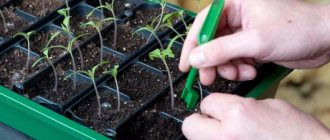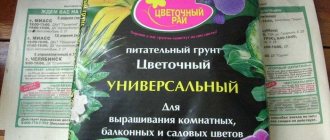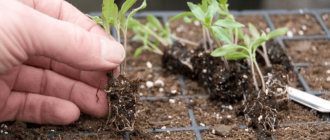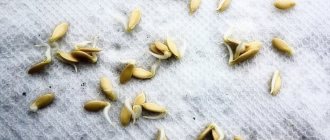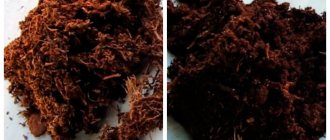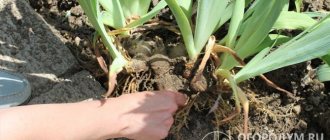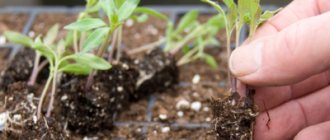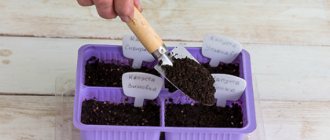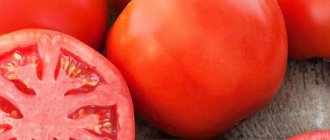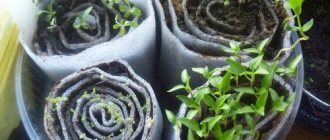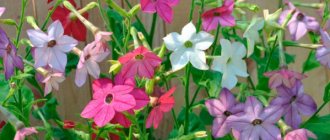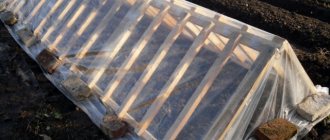Growing vegetable and ornamental crops at the seedling stage requires a lot of attention. And this is quite justified - in many ways, the yield or, if we are talking about flowers, the appearance of plants is determined by the conditions in which their seedlings were, whether they were properly cared for. One of such activities is picking seedlings, and you can find out what it is and how justified it is from this article.
What is seedling picking
Are there any benefits to picking and what are its harms?
Gardeners have different opinions about this procedure; there are supporters and opponents. Some believe that picking is necessary for the successful growth and development of plants, while others are confident that seedlings will grow well without additional human intervention.
But the following advantages of the process are still generally recognized:
- There is no need to thin out the sprouts in the future. Thanks to picking, all weak and underdeveloped seedlings are eliminated at an early stage. As a result, only strong plants remain, which are further grown to adulthood.
- Transplanted crops better tolerate further transplantation to a permanent location. Their root system easily adapts to a new environment.
- Picked seedlings after transplanting into open ground do not get sick, are highly resistant to external environmental conditions and diseases, and their productivity also increases.
- Plants do not stretch or overgrow. After picking, active formation of the root system begins, and the growth of the above-ground part slows down. Therefore, when the stems are stretched excessively, it is recommended to dive.
But the procedure also has disadvantages. The first is that the main root, which is pinched, loses the ability to grow to great depths and extract water from there. This is a minus, especially in hot times. But the problem can be solved by regular and abundant watering.
The second negative point is that there is a risk of seedling death. Although it is very low, it is still there. After all, replanting is always stressful for plants.
What to do to prevent seedlings from stretching.
As you know, due to lack of light, seedlings begin to stretch out and weaken. What often happens when growing seedlings on an apartment window sill. And in greenhouses, for one reason or another, similar incidents happen.
In such cases, it is necessary to use growth regulators on the seedlings, such as the Atlet stimulant or its analog Krepen. These drugs help the seedlings survive the dive. In addition, it prevents the above-ground part of the plant from outgrowing and overtaking the root system in development.
Seedlings can be treated with these preparations either by the root method by watering the soil, or by the foliar method by spraying the above-ground part of the plant.
As soon as the active substance enters the plant cells, it causes a slowdown in growth. Which leads to the redistribution of nutrients entering through the root system.
As a result, after treatment, the plants’ stems become thicker, the leaves increase in size and, most importantly, the root system begins to develop intensively. A good root system means a strong and well-balanced plant.
Which crops require picking and which do not?
Not all plants need picking. The fact is that cultures have different root systems. For example, if a seedling has a very delicate root, it may simply not withstand such interference, and as a result the seedling will die.
There is definitely no need to pick crops such as:
- cucumber;
- melon;
- pumpkin;
- zucchini;
- watermelon.
When 3-4 leaves appear, they are successfully transplanted to a permanent place. Or they are sown immediately in open ground.
Those who grow tomatoes, eggplants, peppers, lobelia and petunia cannot do without picking.
Why is transshipment necessary?
To understand why picking is needed at all, you need to remember the stages of plant development. When a seed germinates, it does not need a large amount of soil. It only needs moisture and good access of oxygen to form roots. Therefore, the seeds are sown in small cups with light soil. The drainage hole prevents water from accumulating, and the light soil provides good aeration.
At the second stage of sprout development, a root system is formed. It is at this stage that he needs more space and nutrition. When growing a plant in the same pot, the roots will very soon begin to crawl out of the drainage holes in search of food. This causes plants to grow weak and thin. Therefore, they are transplanted into larger pots and into a more nutritious mixture. This way, the seedlings will develop roots normally, receive the substances necessary for growth, and grow strong and hardy.
If you sow seeds immediately in large pots, this will cause the plants to grow slowly due to lack of oxygen. Because a large layer of soil will become compacted with each watering, and water will not flow through the drainage holes in sufficient quantities. The seeds will take longer to germinate.
When should you dive?
Transplantation with root pinching is carried out approximately 3 weeks after the sprouts appear. During this period, the plants should grow 3-4 full leaves. It is not recommended to touch them before, but you should not be late with picking.
Transplantation is carried out not only specifically to improve crop growth, but in the following cases:
- seedlings grow too densely, which prevents them from developing normally;
- the sprouts began to hurt and die, so it is urgent to save healthy seedlings;
- The growth of seedlings is excessively rapid; they reach their height prematurely.
The procedure is usually performed once, but sometimes there is a need to repeat it, for example, if there is not enough space for the roots, the stems are strongly stretched upward
Methods for picking plants
There are 3 methods for picking seedlings:
- Pike. You can use a small stick as a pike. With its help, they loosen the soil around the plant and pick up the root without causing severe damage. Before the procedure, it is important to water the soil well. For small seedlings, this technique is simply irreplaceable.
- Finger method. Similar to the first method, but instead of a pike, your own fingers are used. With their help, bushes are removed, and then a hole is made in the new soil, where they are then replanted. It is most convenient to pick large seedlings with your fingers.
- Plank. For this procedure, you will need a thin small board, with which you can remove several plants at once. Thanks to this technique, several crops can be transferred at once. But the quality of such picking is worse than in previous cases.
For transplantation you will need to prepare equipment. You will need water, large containers, soil mixture and a device with which to remove seedlings.
How do I act?
I usually sow seeds in bowls, and then plant the seedlings in boxes, in which they develop well until the budding period, and then I transplant the seedlings into glasses. The seedlings grow strong, well developed and do not stretch.
- Cardiocrinum
But if I had not planted the seedlings on time, no amount of bedding would have helped me grow healthy seedlings: the seedlings would begin to stretch out and compete with each other for light, moisture and nutrition.
This is my point of view, but if anyone has experience in growing seedlings without picking, but only with adding soil between the rows, please share your experience with us.
All the best to you.
Preparing soil and containers
The soil for seedlings needs to be saturated with useful substances. During the picking process, plants experience stress, they have to adapt to a new place, so nutrition is very important for them.
Gardeners advise purchasing ready-made soil in the store. It contains all the necessary elements, and there are definitely no pathogenic microorganisms and weed seeds. You can take soil from your own plot, enriching it with mineral or organic fertilizers.
You can use different containers for picking depending on your taste. You can buy them in specialized stores or adapt something at hand.
For example, many people prefer to plant seedlings in plastic cups, having previously made several holes in the bottom to allow excess moisture to escape.
Gardeners also love peat pots because they can then be planted directly together with seedlings in open ground.
You don’t have to pull out the plants, which greatly simplifies the task and prevents damage to the root system.
What is the meaning of picking
I'll tell you how we do it. In front of me are three bowls with already picked seedlings of Tagetes, Gatsania and Viola. Initially, the seedlings were in smaller bowls, but during picking we increased both the distance between the rows and the distance between the seedlings in the row.
And we did not pick up the pelargonium seedlings, which were sown at the same time, because the sowing was done in a cassette, where each seedling grows in its own cell. That is, at least this seedling will avoid the first picking. If we sowed pelargonium in a bowl and did not pick, the seedlings would no longer have enough space.
But after a couple of weeks, the pelargonium will become a bit crowded in the cassette: the seedlings will begin to compete for light, and the humidity between them will increase greatly. As a result, the plants will begin to experience stress and stretch out.
- Propagation of roses using the Burito and Trannoi method
Picked plants feel great: they are strong, squat, their leaves are rich green, and there is no need to add soil between the rows, because the plants do not compete with each other and do not stretch.
Picking instructions
The transplant procedure consists of several successive stages. You need to do the following:
- Water the crop. This is a mandatory condition regardless of which method you plan to use for picking.
- Determine the planting depth so that the plant is not cramped and the root system can expand freely in the new recess.
- Remove the bush from the pot. This is the most crucial moment, because there is a risk of damaging the roots. Carefully loosen the soil located near the crop, trying not to touch the root system, and remove it.
- Pinch the spine by 1/3.
- Transplant the plant into a new container with a larger size, carefully straightening the roots, and fill the hole with soil.
Depending on the specific crop, the picking process may vary slightly.
For example, sometimes it is necessary to pour water into the hole before transplanting or water the seedlings after the procedure.
The difference between picking and transplanting
Picking seedlings is a transplantation of a seedling, during which the tip of its root is pinched to about a third of its length. This procedure is necessary for the formation of a powerful root system - when growth in length is limited, lateral (additional) branches are formed in large numbers on the main root, which improves the quality of nutrition and strengthens the plant in the soil.
Many gardeners call ordinary transplanting of seedlings “picking”. This is incorrect because not only the process itself is different, but also its result. Picking is precisely pinching off the tip of the root when planting; other procedures do not fall under this definition.
“Resettlement” of seedlings without picking (shortening the main root) is carried out in 2 ways:
- transshipment with a lump of earth;
- transplantation (without preserving the coma).
When transferred to larger pots, the main root is not shortened, and there is no incentive to increase the area of the root system. The advantage is minimal trauma - a lump of earth prevents damage, seedlings quickly grow, while after cutting off the main root by a third of its length, the plants need some time to adapt.
Related article:
Why do seedlings rot and what to do?
If young seedlings are planted without preserving a clod of soil, then it is important not to miss the deadline. When sowing densely, the roots intertwine with neighboring ones and the more time passes, the more difficult it is to separate the plants from each other. During the separation process, not only the central parts of the root are damaged, but also the lateral branches, which, unlike deliberate pinching, only causes harm.
Important to know: When to sow seeds for seedlings
Caring for seedlings after picking
If anyone thinks that after transplanting they can put the seedlings on the windowsill and only water them periodically, they are deeply mistaken. After picking, plants need careful care. After all, the following measures still need to be taken:
- organize optimal lighting;
- water;
- apply fertilizers;
- ensure that crops are not exposed to pests and diseases.
Harden off seedlings
If necessary, re-picking may be necessary in the future.
How to properly plant seedlings of annual flowers. Tips, recommendations
We often sow seeds thickened.
Firstly, because they are small and it is quite difficult to sow them at the required distance, and secondly, of course, because we do not know what their germination rate will be.
All about creating a lawn. Best recommendations. Reading...
And therefore, in order for our seedlings to develop well, they have enough nutrition and space for proper growth and development, it is necessary to pick them out, or, more simply, to plant them less frequently.
The term "picking" comes from the French. “piquet”, which means stake, peg. Initially, picking was the name for early transplantation of seedlings, carried out under a peg (pike). Currently, plant picking refers to transplanting seedlings by pinching the main root.
Picking is carried out to increase the feeding area of plants, better illumination and development of the root system. Picking seedlings helps select only strong and healthy seedlings. Underdeveloped seedlings are discarded.
Now let’s take a more specific look at picking seedlings of different types of annuals.
| Plant name | Features of picking |
| Ageratum | They are picked into boxes according to a 4x4 cm pattern, the plants develop quickly, if necessary, repeated picking is carried out later |
| Aster | Dive into boxes according to a 6x6 cm pattern |
| Alyssum | Dive into boxes according to a 5x5 cm pattern, 2-3 pieces each. into the hole |
| Balsam | Dive into boxes according to a 9x6 cm pattern, or into separate pots with a diameter of 9 cm. |
| Marigold | When the planting is dense, they dive according to the 4x5 cm pattern. |
| Verbena | Dive into separate pots with a diameter of about 10 cm. |
| Viola | Dive into boxes according to a 5x5 cm pattern. |
| Chinese carnation | Dive into boxes according to a 2x2 cm pattern. |
| Carnation Shabo | They dive 2 times. The first is in boxes with the appearance of the first true pair of leaves, the second in the second half of March in separate pots. |
| Dahlias | Dive into separate boxes according to a 4x4 cm pattern. |
| Godetia | Dive carefully into separate pots of 3 pieces. (does not tolerate transplantation well) |
| Osteospermum | Dive into separate pots. (But it’s better either in pots or directly in the ground) |
| Cleome | Dive as early as possible into separate pots. |
| Kobeya | Dive into separate pots one at a time. Install small rods for support. |
| Levkoy | Dive into boxes according to a 4x4 cm pattern. |
| Lobelia | Dive in small bunches according to a 4x4 cm pattern. For convenience, you can use a spoon. |
| Snapdragon | Dive into boxes according to a 4x4 cm pattern. |
| Petunia | They dive into boxes at a distance of 4-5 cm. It is better to dive especially beautiful hybrid varieties into separate pots. |
| Salvia | Dive into boxes at a distance of 4-5 cm, and after 3 weeks into separate pots. |
| Fragrant tobacco | Dive into separate pots |
| Celosia | They pick into boxes at a distance of 5 cm; if necessary, a second pick is carried out into separate pots. |
| Cineraria | Dive into boxes at a distance of 5 cm. |
| Zinnia | Dive into boxes at a distance of 5 cm. |
All about creating a reservoir. Reading
Picking begins when the seedlings have 1–2 true leaves. All flower crops that have a taproot, weakly branched and underdeveloped root system (especially gillyflower and petunia) are planted in isolated containers so that the roots are less damaged when planted in the ground.
For most crops, 5–8 cm cassettes are best. Large plants - castor beans, kochia, etc. - dive into 8-10 cm pots. Slow-growing small-seeded crops, planted twice: first in 1–2 cm cassettes, then in 8–10 cm pots or cassettes.
In the first picking, Lobelia is planted with several seedlings per hole, since they are too small. When picking into boxes, seedlings are planted at a distance of 2.5 - 3 cm, large ones - 5 - 6 cm. Denser picking leads to stretching of the stems and diseases.
The soil mixture for sowing seedlings and picking seedlings is prepared in the fall. You can, of course, use ready-made soil for growing flowers, but experienced gardeners prefer to prepare soil mixtures themselves.
All about building a rock garden. Reading...
Their composition may vary somewhat, but, as a rule, they consist of turf (or leaf, garden) soil, peat, humus and sand. The optimal ratio of these components is 2:2:2:1; however, it may vary depending on their original quality.
Before starting work, water the seedlings and give time for the water to be absorbed.
There are several picking methods:
- Picking under a peg
- Finger pick
- Picking under the bar
Picking under a peg
Using a picking peg, depressions are made in prepared containers with soil. Then the peg is immersed in a box with seedlings, carefully lifted and the seedlings are taken out along with the soil. With your left hand you take the plant by the cotyledons, and with your right hand you lightly pinch the root.
Place the seedling in the prepared hole, deepen it a little, without covering the cotyledon leaves with soil. If the seedling is planted high, it does not take root well, and if the seedling is buried, the growing point rots and the plant dies.
Using a peg, the bent roots are straightened and pressed to the side, after which the hole is filled with soil and lightly pressed down at the base of the stem. Under plants that are severely affected by blackleg, add fried sand in a layer of 0.5 - 1 cm.
seedling cont.
the seedling is right.
Sequence of actions when picking under a peg
All about growing hostas. Best recommendations. Reading...
Picking plants under your finger
The second method differs from the first in that the hole is made with the index finger to a depth equal to the height of the finger. Picking under a finger is 2-3 times faster than picking under a peg.
Sequence of actions when picking under a finger
Picking plants under the plank
This method is used when picking a large number of seedlings and allows you to pick 15-20 seedlings at the same time. In this way, you can dive into a box or into a bed in a greenhouse.
To do this, make a furrow in the area, spill it with water, lay the seedlings and, using a wooden plank, sprinkle the lower part of the seedlings. This method is the fastest, but the quality of the picking suffers.
All about roses. Best recommendations. Reading...
After picking, the seedlings are watered abundantly. At first, picked plants need special care. They are placed in a cool place with high humidity and shaded from direct sunlight until they take root. After 3-5 days, the plants are returned to the windowsill.
Pinching plants
Pinching, or more simply put, pinching plant seedlings, is used for better tillering, and as a result, more abundant flowering of plants.
After pinching the top of the plant, its growth slows down a little, and the lateral buds begin to wake up, from which new shoots are formed. Pinching plants for excessively elongated, overgrown seedlings will be especially useful.
Like any intervention, pinching is stressful for the plant and in order to reduce risks and bring benefit to the plant rather than harm, it is necessary to follow some rules.
Thus, plants can be pinched only after the formation of at least four to five true pairs of leaves. The top should be plucked off. Do not pinch sick or weakened plants, as well as plants immediately before or after transplanting.
Among the annuals, pinch out Shabot carnation, gillyflower, snapdragon, annual phlox, salvia, verbena, zinnia, petunia (with the exception of new hybrid varieties F1).
All about creating a garden with your own hands. The best. Reading...
Please note this:
| Creating a garden | All about garden plants | We are building a house |
| All the flowers are here | Creating a lawn | We are building a bathhouse |
| Reservoir design | What would happen without a rock garden... | All about roses |
Popular:
- Growing flower seedlings according to all the rules
- Secrets of growing Lobelia: growing seedlings, planting, transplanting
- Growing petunias, where and how, growing methods, growing rules, secrets of abundant flowering.
- How to properly sow, plant and replant flower crops
- How to prepare flower seeds for sowing seedlings
Next:
- Rules for growing strong, good seedlings of annual dahlias from seeds.
- Growing verbena from seeds. Nuances, recommendations, tips
- We grow garden balsam from seeds. Subtleties and complexities.
- Is it difficult to grow alyssium (lobularia) from seeds. How to do it right. Tips, recommendations
- Ageratum is grown from seeds. Difficult? Which is correct?
Previous:
- Annual flowers grown by seedlings. Photo, description
- In which container is it better to grow seedlings for annual flowers?
- We grow Shabot cloves from seeds. How to do it right
- What you need to know to start successfully growing flower seedlings.
- How to grow petunia correctly - sowing and care
